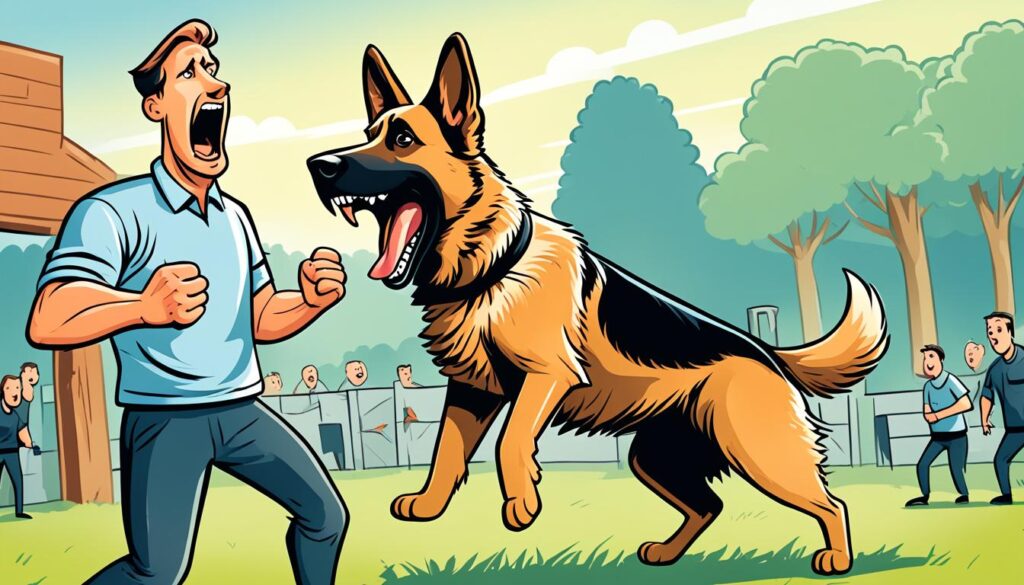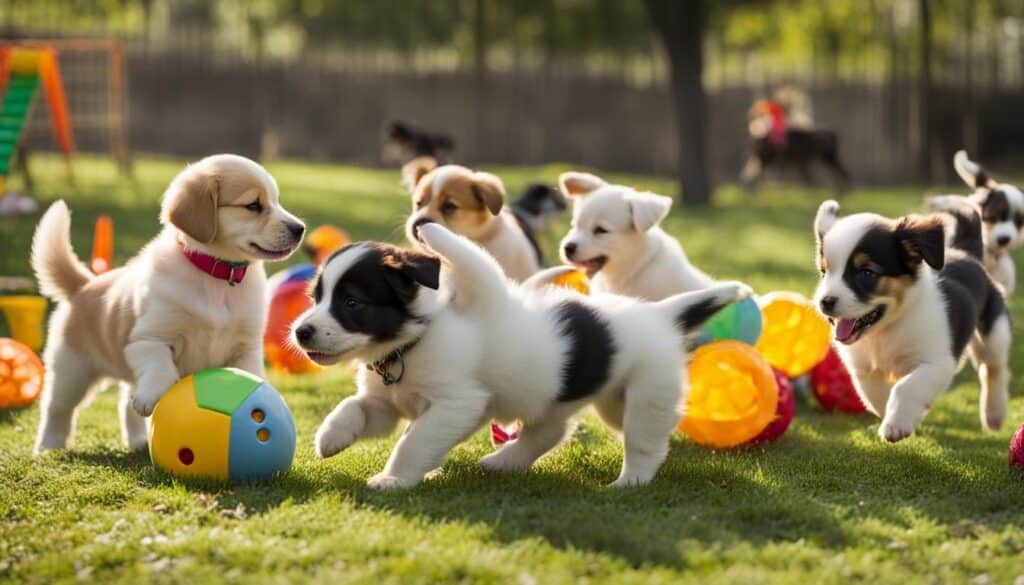In today’s world, ensuring the safety and security of our homes and properties is paramount. That’s why guard dog training has become essential for many dog owners. By harnessing the potential of their canine companions, they can rely on these loyal and efficient guard dogs to provide protection and peace of mind.
In this comprehensive guide, we will explore the strategies for successful guard dog training, uncovering proven techniques that have been refined over time. From understanding the characteristics of a good guard dog to mastering advanced training techniques, you will gain the knowledge and skills necessary to train your dog effectively.
So, whether you’ve just brought home a new puppy or want to enhance your existing dog’s skills, this guide will provide valuable insights, practical tips, and step-by-step instructions to unlock the full potential of your guard dog.

Key Takeaways:
- Guard dog training is crucial for ensuring the safety and security of your home or property.
- Understanding the characteristics of a good guard dog and the commitment required is essential before training.
- Choosing the right dog breed is crucial for successful guard dog training.
- Foundational training techniques, such as basic obedience and teaching the dog to bark on command, are essential.
- Advanced training techniques for personal protection dogs require expertise and professional guidance.
Why Choose a Dog for Guard Duties?
When it comes to ensuring the safety and security of your home or property, having a well-trained guard dog can be a game-changer. But why choose a dog for guard duties in the first place?
What makes a good guard dog?
A good guard dog possesses unique traits that make it highly effective in protecting its territory and its people. These traits include:
- Intelligence: A good guard dog is intelligent and can quickly learn and understand commands.
- Loyalty: Guard dogs are fiercely loyal to their owners and will instinctively defend them if necessary.
- Trainability: They are trainable and responsive to consistent and firm training techniques.
- Territoriality: Guard dogs naturally exhibit a solid territorial instinct, which makes them highly vigilant and protective of their surroundings.
The traits that every guard dog must have
Apart from the specific traits mentioned above, every good guard dog should possess the following characteristics:
- Alertness: They should be highly alert and able to sense potential threats or dangers.
- Courage: Guard dogs must be brave in the face of danger.
- Physical presence: They should have a strong and imposing physical presence, which can help deter potential intruders.
- Good judgment: A reliable guard dog can differentiate between genuine threats and harmless situations.
Understanding the commitment: Is a guard dog right for you?
While guard dogs can provide invaluable protection, it’s essential to understand the commitment involved in owning and training one. Consider the following factors before deciding if a guard dog is the right fit for you:
- Time: Guard dogs require consistent training, exercise, and attention. Make sure you have enough time to devote to their needs.
- Resources: Owning a guard dog involves additional expenses, including food, grooming, veterinary care, and potentially professional training.
- Legal considerations: Familiarize yourself with the laws and regulations regarding guard dogs in your area to ensure compliance.
By carefully considering these factors and evaluating your capabilities and lifestyle, you can decide whether a guard dog is the right choice for you.

Identifying the Right Dog Breed for Guarding
When guard dog training, choosing the right dog breed is paramount. The breed you select should possess the qualities and instincts for guarding and protection. In this section, we will debunk common myths about guard dog breeds and provide insights into the suitability of different breeds for effective guard duty.
Large vs. Small Dog: Debunking the Myths about Guard Dog Breeds
One common misconception is that only large dogs are suitable for guarding. While large breeds such as German Shepherds and Rottweilers are popular choices, smaller breeds can also excel in guard duty. The effectiveness of a guard dog depends on factors beyond its size.
Smaller dogs, like Jack Russell Terriers or Miniature Schnauzers, possess traits that make them exceptional guard dogs despite their size. They are often more agile and alert and possess a strong instinct to protect their territory and loved ones. It’s essential to consider a dog’s temperament and drive rather than solely focusing on its size.
Top Breeds for Effective Guard Duty
While many breeds can excel in guard duty, several stand out for their natural guarding instincts and renowned effectiveness in protecting properties and individuals. These breeds include:
- German Shepherd: Known for their intelligence, loyalty, and trainability, German Shepherds are a popular choice for guard dog training. Their size, strength, and excellent working abilities make them competent guard dogs.
- Rottweiler: Rottweilers are powerful, confident dogs that are naturally protective of their family and territory. They are known for their intelligence and ability to assess situations, making them an excellent choice for guard duty.
- Doberman Pinscher: Highly intelligent, alert, and loyal, Doberman Pinschers are often utilized as guard dogs. Their natural protective instincts make them ideal for guarding homes and properties.
- Belgian Malinois: Known for their energy, drive, and athleticism, they are frequently employed in various law enforcement roles. Their exceptional work ethic and quick learning abilities make them an excellent choice for guard duty.
Analyzing the Temperament and Instinct of Potential Guard Dogs
When selecting a dog breed for guarding, it’s crucial to analyze its temperament and instinct. Each breed has unique characteristics that determine its suitability as a guard dog. Some dogs naturally possess a protective solid drive, while others may require additional training to develop this instinct.
Consider the specific temperamental traits of a breed, such as alertness, territoriality, and the ability to assess and respond to potentially threatening situations quickly. Understanding a breed’s temperament and instinct will help you identify a dog that aligns with your needs and requirements for a reliable guard dog.

Foundational Guard Dog Training Techniques
Building a solid foundation is essential for practical guard dog training. By mastering the basics, you can ensure that your canine companion is equipped with the necessary skills to fulfill their role as a guard dog. In this section, we will explore critical techniques that form the basis of guard dog training, including basic obedience training, structuring training sessions, teaching your dog to bark on command, and mastering key commands.
One of the fundamental aspects of guard dog training is basic obedience training. This involves teaching your dog essential commands such as “sit,” “stay,” “come,” and “heel.” Basic obedience training establishes a line of communication between you and your dog, enabling you to convey your expectations and ensure their compliance effectively. Your dog will develop the discipline and focus necessary for advanced training through consistent practice and positive reinforcement.
Structuring your dog’s training sessions is another crucial aspect of their development as a guard dog. A straightforward routine creates a structured learning environment that helps your dog understand and anticipate their training sessions. Consistency is critical, so ensure you allocate regular time slots for training and stick to the predetermined schedule. The structure also includes:
- Setting clear boundaries and establishing rules.
- Reinforcing your role as the pack leader.
- Fostering a sense of respect and discipline in your dog.
Teaching your dog to bark on command is essential in their guard dog training journey. You can unleash their natural guarding instincts by training them to bark on cue and employ their vocal abilities as a deterrent. To achieve this, start by selecting a specific command, such as “speak,” and associate it with the action of barking. Gradually reinforce the association through verbal cues and rewards, ensuring your dog understands that barking on command is acceptable and expected behavior.
Mastering key commands is essential for every guard dog. Alongside basic obedience commands, there are several vital commands that your dog should learn to ensure their effectiveness in guard duty. These commands include “sit,” which establishes control and helps calm your dog in potentially stressful situations. “Stay” is another crucial command that ensures your dog remains in position until instructed otherwise. “Leave it” is critical for redirecting your dog’s attention away from potentially dangerous or distracting stimuli. These key commands enable you to maintain control of your dog and ensure their reliability in guard dog duties.
Advanced Training for Personal Protection Dogs
Once you have established the foundation of guard dog training, it’s time to explore advanced techniques for personal protection dogs. These specialized training methods allow you to take your dog’s skills to the next level, ensuring their effectiveness in protecting you and your property.
When and how to introduce attack dog training safely
Introducing attack dog training should be approached with caution and proper guidance. It is essential to prioritize safety and ethical considerations during this training phase. The timing of introducing attack training varies depending on the dog’s age, temperament, and level of obedience. It is recommended to consult with a professional dog trainer experienced in working with personal protection dogs to ensure a safe and effective training process.
Balancing aggression with obedience: Training your dog to protect on command.
One of the critical challenges in advanced training is striking the right balance between aggression and obedience. While your dog needs to protect you and display controlled aggression when necessary, it’s equally crucial to have reliable obedience commands. This balance ensures that your dog understands when to be assertive and exhibits self-control. Consistent and structured training is vital for achieving this delicate balance, reinforcing protective instincts and obedience commands.
The role of a professional dog trainer in honing your guard dog’s skills
Working with a professional dog trainer specializing in advanced guard dog training is highly recommended. They possess the expertise and experience necessary to fine-tune your dog’s skills and maximize their potential as a personal protection dog. A professional trainer can assess your dog’s strengths and weaknesses, tailor training programs to address specific challenges and offer invaluable guidance to ensure the highest level of proficiency in your dog’s training.
| Training Technique | Description |
| Decoy Training | Simulates real-life attack scenarios to teach your dog to differentiate between genuine threats and innocent individuals. |
| Bite Development | Develops bite strength and precision, ensuring controlled bites and the ability to immobilize an assailant if required. |
| Targeting Specific Areas | Trains your dog to target specific body parts of an assailant, maximizing their effectiveness and minimizing potential harm. |
| Off-Leash Training | Teaches your dog to respond to commands and perform protection tasks in various environments without a leash. |
With the guidance of a professional trainer and the implementation of these advanced training techniques, you can transform your dog into a capable and reliable personal protection companion.
Common Challenges in Training a Guard Dog
Training a guard dog presents a unique set of challenges that dog owners must overcome. This section will explore these common challenges and provide practical tips to help you navigate them successfully. From overcoming stubbornness to finding the right balance between socialization and guard duty, we’ll address the critical aspects of guard dog training. Additionally, we’ll discuss training techniques to address excessive barking and teach your dog to bark only when necessary.
Overcoming stubbornness: Tips for a successful training session
- Be patient and consistent in your training approach.
- Use positive reinforcement techniques, such as rewards and treats, to motivate your dog.
- Break down training tasks into smaller, manageable steps.
- Provide mental stimulation and interactive play sessions to motivate your dog.
- Seek professional guidance from a qualified dog trainer if needed.
Each dog is unique, and what works for one may not work for another. Tailor your training methods to suit your dog’s personality and needs.
Socialization vs. Guard Duty: Finding the Balance for a Well-rounded Guard Dog
When training a guard dog, it’s essential to balance socialization and guard duties.
Socialization allows your dog to develop positive interactions with different people, animals, and environments. This helps them become well-rounded and confident. However, it’s crucial to maintain their protective instincts and teach them when to switch into guard mode when the situation calls for it.
Here are some strategies to achieve this balance:
- Expose your dog to various social situations from an early age, such as visits to the park, interactions with friendly strangers, and controlled introductions to other animals. This helps them develop good social skills.
- Integrate obedience training with socialization exercises to reinforce your dog’s ability to differentiate between friendly interactions and potential threats.
- Gradually introduce your dog to their guard duties through controlled scenarios and professional guidance. This ensures they understand the appropriate times to protect and when to relax.
- Continuously reinforce positive behavior and reward your dog for balancing socialization and guard duty.
Dealing with excessive barking: Train your dog to bark only when necessary.
Excessive barking can be a challenge when training guard dogs. To address this issue, it’s essential to establish clear guidelines and teach your dog to bark only when necessary. Here are some training techniques to help you achieve this:
- Teach a specific command, such as “speak” or “quiet,” to control your dog’s barking behavior. Reward them when they respond appropriately to the command.
- Identify the triggers that cause excessive barking and work on desensitizing your dog to those triggers through gradual exposure and positive reinforcement.
- Provide mental and physical stimulation to prevent boredom, as excessive barking can result from pent-up energy or frustration.
- Seek professional assistance if the excessive barking persists despite your training efforts. A qualified dog trainer can provide tailored guidance and techniques to address this behavior.
Consistent training and patience are essential when addressing excessive barking behavior. Celebrate small victories and be persistent in your approach.
Maintaining Your Guard Dog’s Skills and Well-being
Guard dog training is not a one-time endeavor; it requires continuous effort to maintain your canine companion’s skills and overall well-being. By prioritizing ongoing training, mental stimulation, physical fitness, and understanding the signs of stress in guard dogs, You can ensure that your guard dog remains in excellent condition.
The importance of continuous training and mental stimulation
To keep your guard dogs sharp and effective, engaging them in continuous training is crucial. Regular training sessions reinforce their skills, improve obedience, and maintain focus. Incorporate mental stimulation into their routine, such as puzzle toys, scent detection games, and obedience drills. These activities challenge their intellect, keeping them engaged and mentally sharp.
Physical fitness: Keeping your guard dog in peak condition
A physically fit guard dog is better prepared to handle the demands of their duties. Regular exercise is essential for their strength, endurance, and overall health. Structured activities like long walks, jogging, playing fetch, or agility training help maintain their physical fitness level. Consider your dog’s breed, age, and any specific exercise requirements they may have.
Understanding and addressing the signs of stress in guard dogs.
Guard dogs may experience stress, affecting their performance and overall well-being. As a responsible owner, you must recognize your dog’s stress signs. These may include excessive panting, drooling, pacing, aggression, or changes in appetite. If you notice any of these signs, addressing them promptly is essential.
Ensure that your guard dog has a balanced and peaceful environment. Please provide them with a comfortable and safe living space, regular socialization opportunities, and adequate rest. If you observe persistent signs of stress, consider consulting a professional dog trainer or veterinarian for guidance.
You can keep your four-legged protector fit and efficient by maintaining your guard dog’s skills through continuous training, providing mental stimulation, prioritizing physical fitness, and addressing signs of stress. A well-maintained guard dog will ensure your property’s safety and security and lead a happy and fulfilled life.
Conclusion
In conclusion, becoming proficient in guard dog training requires dedication, knowledge, and a profound understanding of your dog’s unique traits and needs. By implementing the proven techniques and tips outlined in this comprehensive guide, you can unlock the untapped potential of your canine companion, transforming it into a reliable and efficient guard dog.
Guard dog training is a continuous journey that necessitates patience and unwavering commitment. With time and consistent effort, you will witness the remarkable results of having a well-trained guard dog by your side.
Embrace the rewards of having a devoted and highly skilled guard dog on your property. The safety and security they provide and their unwavering loyalty will bring you immeasurable peace of mind.
FAQs
Q: What are the different types of guard dogs?
A: Types of guard dogs vary widely based on their breed characteristics and training. Some well-known breeds that make good guard dogs include German Shepherds, Dobermans, Rottweilers, and Belgian Malinois. Each type of dog brings specific strengths to their guard duties, from natural protective instincts to strength and intelligence.
Q: How can you train a dog to be a reliable guard dog?
A: Training a dog to become a reliable guard requires several training levels, from basic obedience to more advanced guard training. The dog should understand and obey basic commands like sit, stay, and come. As part of the training, you must also socialize your dog from a young age to ensure they are well-adjusted and distinguish between normal and suspicious behavior.
Q: What are the essential training tips for preparing a dog to guard?
A: Key training tips include starting socialization and obedience training early, gradually introducing your dog to various situations, and rewarding them for desirable behavior. It’s important to encourage your dog to bark in situations requiring alertness but also train it to stop barking on command. Consistency and patience are crucial aspects of teaching a guard dog.
Q: Is any specific type of dog suited to becoming a guard dog?
A: While many people believe that certain breeds are naturally better at guarding, the truth is that most dogs can be trained to guard with the right type of training. However, breeds known for their protective nature, intelligence, and physical strength, such as German Shepherds and Dobermans, are often preferred for guard dog duties.
Q: How do you train your dog to attack on command?
A: Professional trainers should only train a dog to attack due to the potential risks. This advanced training builds upon basic obedience, where the dog learns to attack a specific command and, more importantly, to cease the attack when given another command. This aspect of training is critical for ensuring the dog’s and others’ safety.
Q: Can you train any dog to be a guard regardless of age?
A: While it’s easier to train a dog from a young age since puppies are more malleable, older dogs can also be trained to guard. The key is adjusting the training approach to suit the dog’s learning pace, emphasizing repetition and positive reinforcement for older dogs.
Q: How important is training a dog to stop barking on command?
A: Training a dog to stop barking on command is crucial for a guard dog, as it ensures that the dog can alert you to potential threats without becoming a nuisance. It helps differentiate between regular occurrences and genuine threats. Moreover, it is an essential control mechanism to ensure the dog responds appropriately to the owners’ commands in every situation.
Q: How important is it to socialize your dog as part of training them to be a guard dog?
A: Socialization is a critical aspect of training a guard dog. Proper socialization ensures the dog is well-adjusted and can accurately distinguish between every day, non-threatening situations and actual threats. It helps curb aggressive behavior towards friends, family, and non-threatening strangers. Socializing with your dog enables them to become reliable and safeguard dogs.

